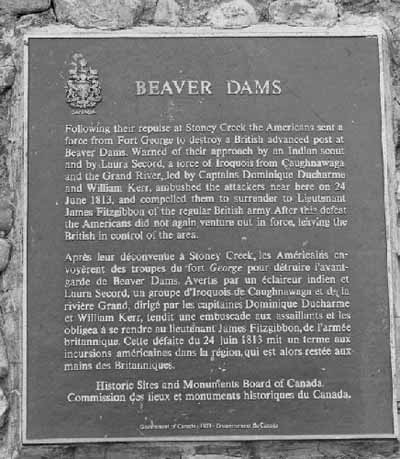Battle of Beaver Dams National Historic Site of Canada
Thorold, Ontario

General view
(© Parks Canada Agency / Agence Parcs Canada, 1989.)
Address :
Sullivan Avenue, Thorold, Ontario
Recognition Statute:
Historic Sites and Monuments Act (R.S.C., 1985, c. H-4)
Designation Date:
1921-05-21
Dates:
-
1813 to 1813
(Significant)
Event, Person, Organization:
-
Battle of Beaver Dams
(Event)
-
War of 1812
(Event)
-
Lieutenant James Fitzgibbon
(Person)
-
Lieutenant-Colonel Charles G. Boerstler
(Person)
-
Captain Dominique Ducharme
(Person)
-
Captain William Kerr
(Person)
-
Laura Secord
(Person)
-
Iroquois Scout, name unknown
(Person)
-
Caughnawaga Iroquois
(Organization)
-
Grand River Iroquois
(Organization)
Other Name(s):
-
Battle of Beaver Dams
(Designation Name)
-
Battle of Beechwoods
(Other Name)
Research Report Number:
2007-CED/SDC-035
Plaque(s)
Existing plaque: Battle of Beaverdams Park, Thorold, Ontario
Following their repulse at Stoney Creek the Americans sent a force from Fort George to destroy a British advanced post at Beaver Dams. Warned of their approach by an Indian scout and by Laura Secord, a force of Iroquois from Caughnawaga and the Grand River, led by Captains Dominique Ducharme and William Kerr, ambushed the attackers near here on 24 June 1813, and compelled them to surrender to Lieutenant James Fitzgibbon of the regular British army. After this defeat the Americans did not again venture out in force, leaving the British in control of the area.
*Note: This designation has been identified for review. A review can be triggered for one of the following reasons - outdated language or terminology, absence of a significant layer of history, factual errors, controversial beliefs and behaviour, or significant new knowledge.
Description of Historic Place
The Battle of Beaver Dams National Historic Site of Canada is a large open industrial landscape including part of the Welland Canal on the east side of the City of Thorold, Ontario. Located south of the Niagara escarpment, it was the site of a decisive British victory during the War of 1812, between Iroquois and American forces. The site encompasses a variety of properties including urban residential property in Thorold, parts of the Welland Canal, a cemetery, and industrial land. Official recognition refers to the site on its legal lots.
Heritage Value
The Battle of Beaver Dams was designated a National Historic Site of Canada in 1921. It is designated because: warned by Laura Secord and an Iroquois scout, a force of Iroquois from Caughnawaga and the Grand River defeated an attacking American force near Beaver Dams on 24 June 1813; the American defeat left the British in control of the Niagara area for the remainder of 1813.
The Battle of Beaver Dams, which occurred on June 24 1813, was a crucial battle during the War of 1812. Following their defeat at Stoney Creek, the Americans sent a force under Lieutenant-Colonel Charles G. Boerstler from Fort George to destroy a British advanced post at Beaver Dams. A force of about 600 infantry and cavalry left Fort George for American-controlled Queenston so as not to reveal the true destination of their mission. At Queenston, Laura Secord, the wife of a wounded Loyalist, overheard the American plans and journeyed, with an Iroquois scout, to warn the British of the pending attack. Forewarned, a combined force of Iroquois from Caughnawaga and the Grand River, led by Captains Dominique Ducharme and William Kerr, ambushed the American force and compelled them to surrender to British Lieutenant James Fitzgibbon of the regular British Army. After their defeat, the Americans left the British in control of the Niagara area for the remainder of 1813.
Sources: Historic Sites and Monuments Board of Canada, Minutes, 1966; 1970; 1975; 2007.
Character-Defining Elements
The key elements that contribute to the heritage character of this site include: its location at the east end of Thorold, Ontario; the open industrial and rural character of the landscape that includes parts of the Welland Canal; the integrity of any surviving or as yet unidentified archaeological remains which may be found within the site in their original placement and extent; viewscapes from the battlefield across the Welland Canal.